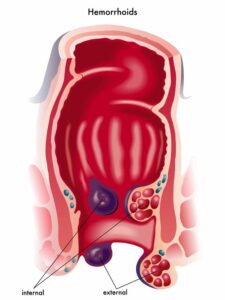Hemorrhoid Embolization
A Minimally Invasive Treatment for Hemorrhoids

Hemorrhoid embolization is a minimally invasive treatment for internal hemorrhoids that offers long-lasting relief from rectal bleeding. Hemorrhoids form when abnormal connections are made between arteries and veins in the rectum. Embolization works by blocking these abnormal blood vessel connections, which eliminates the bleeding.
The procedure is performed by interventional radiologists – doctors specially trained to do minimally invasive vascular procedures, such as angioplasty and embolization, to treat a variety of conditions.
During the procedure, a doctor positions a catheter through a small needle puncture in the leg and into the blood vessels that supply the rectum using x-ray guidance. Once positioned, tiny coils are slowly released that block the blood supply to the hemorrhoids and stop the bleeding.
Hemorrhoids are swollen, enlarged veins that form inside and outside the anus and rectum. They can be painful, uncomfortable and cause rectal bleeding. Hemorrhoids are also called piles.
An estimated 1 in 20 Americans have symptomatic hemorrhoids. They affect people of all ages, genders, races and ethnicities. They’re more common as you age, affecting more than half of people over age 50.
Straining puts pressure on veins in the anus or rectum, causing hemorrhoids. Any sort of straining that increases pressure on your belly or lower extremities can cause anal and rectal veins to become swollen and inflamed.
Hemorrhoids may develop due to:
- Pelvic pressure from weight gain, especially during pregnancy.
- Pushing hard to have a bowel movement (poop) because of constipation.
- Straining to lift heavy objects or weightlifting.
Internal hemorrhoids rarely cause pain (and typically can’t be felt) unless they prolapse. Many people with internal hemorrhoids don’t know they have them because they don’t have symptoms.
Bleeding is the most common presenting symptom. If you have symptoms of internal hemorrhoids, you might see blood on toilet paper, in stool or the toilet bowl. These are signs of rectal bleeding.
- Itchy anus.
- Hard lumps near the anus that feel sore or tender.
- Pain or ache in the anus, especially when you sit.
- Rectal bleeding.
Prolapsed hemorrhoids can be painful and uncomfortable.
If you are experiencing some or any of these symptoms, know that there are options for the type of treatment available. When considering the various hemorrhoid treatment options available, you should weigh the risks and benefits of each procedure.
Fibroid embolization typically lasts one to two hours. You can go home the same day or choose to stay overnight to recover.
The procedure involves several steps:
- The doctor makes a tiny incision in the wrist or the groin.
- Using specialized X-ray equipment, the doctor passes a catheter to the arteries leading to the uterus.
- Upon reaching the proper location in the uterus, the doctor injects the microspheres through the catheter and into the fibroids’ blood flow.
- The doctor completes the embolization and then gently removes the catheter.
- The doctor applies pressure to the puncture site to prevent bleeding and places a small bandage.
- You may experience some discomfort, such as abdominal cramping or pain. You and your doctor will determine what medications you may need to stay comfortable.
- Hemorrhoids embolization is a minimally invasive outpatient procedure with no incision needed
- Requires only local (rather than general) anesthesia
- Does not cause scarring like surgical techniques do
- While there will be some moderate pain after a hemorrhoid embolization procedure, it is typically less intensive than post-surgical pain
- Faster recovery time compared to surgery
- Same day procedure, typically no overnight stay needed, so you can recover at home
- Reduced risk of infection as compared to surgery
- Easy to make and quickly schedule an appointment at an outpatient center
At Unified Vascular and Wound Care Institute, we work every day to deliver far more than our patients expect. We bring our full range of medical capabilities and service excellence to every patient, every visit at each of our centers nationwide.
